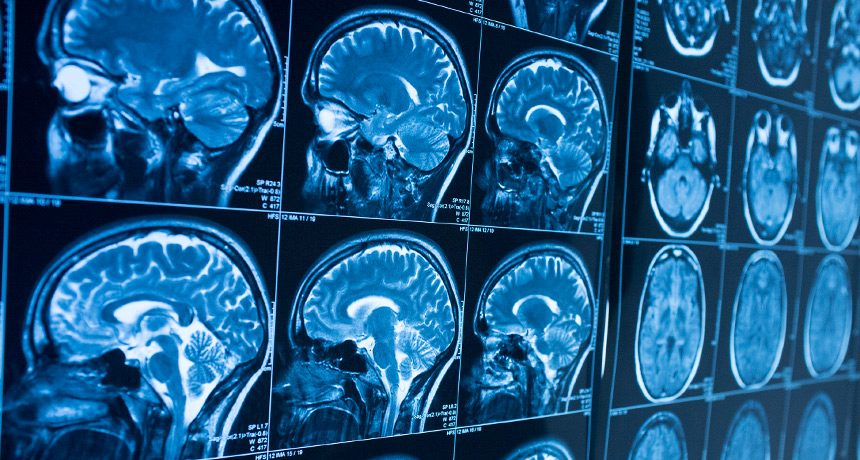Hormone affects how teens’ brains control emotions
As adolescents mature, rising testosterone gives their brains more control over emotions

Using scans of brain activity, scientists were able to show that how teens’ brains process emotions changes as they mature.
Movus/istockphoto
Adolescence can mean facing the emotional challenges of adults for the first time. But what part of a teen’s brain processes those emotions depends on how mature that brain is, a new study finds.
As kids grow up, hormone levels will begin to surge in areas of their brains that manage emotions. The first surge starts deep within the brain. With time and maturity, some areas right behind the forehead will also get involved. And those new areas are important. They can be key to making decisions that allow teens to keep their cool.
When adults process an emotion — if they see an angry face, for example — multiple places in their brains will turn on. One area is the limbic system — a group of small brain areas deep in the brain where emotion processing starts. Adults also show activity in the prefrontal cortex. This is that area behind the forehead that plays a role in making decisions. The limbic system may advise an adult to scream or fight. The prefrontal cortex helps to keep unwise urges in check.
The brain of a young teen isn’t just a bigger version of a small kid’s. It isn’t a smaller version of an adult’s, either. As children grow, their brains morph. Some areas mature and build connections. Other areas may disconnect or get trimmed away. Brain areas that process emotions mature very quickly. The prefrontal cortex does not. This leaves the emotion-processing centers on their own for a while.
The amygdala (Ah-MIG-duh-lah) is an area deep within the limbic system that deals with emotions such as fear. “Adolescents activate the amygdala more in emotional…situations,” says Anna Tyborowska. Meanwhile, their prefrontal cortex is not yet ready to take control over emotional processing.
Tyborowska is a neuroscientist at Radboud University in Nijmegen, the Netherlands. (A neuroscientist is someone who studies the brain.) She became part of a team that recruited 49 boys and girls for a brain study.
All her team’s recruits were 14 years old. During tests, each lay very still inside an fMRI scanner. (That acronym stands for functional magnetic resonance imaging.) This machine uses powerful magnets to measure blood flows throughout the brain. As the brain takes on tasks, such as reading or managing emotions, blood flow can increase or decrease in different areas. This points to which parts of the brain are most active.
While in the scanner, each teen used a joystick to perform a task. When viewing a smiling face on a computer screen, each was initially supposed to pull the joystick inward, for instance. For an angry face, each was supposed to push the joystick away. These were easy tasks to remember. People are, after all, attracted to happy faces and want to stay away from angry ones.
For the next task, teens were told to pull the stick toward themselves when they saw an angry face and push it away when they saw a happy face. “Approaching something threatening is an unnatural response that requires self-control,” explains Tyborowska. To succeed at this task, the teens had to control their emotions.
The scientists measured which areas of the brain were active as the teens performed each task. They also measured each teen’s level of testosterone. This is a hormone that rises during puberty.
Testosterone is associated with muscles and size in males. But that’s not all it affects. The hormone is present in both sexes. And one of its roles is “in reorganizing the brain during adolescence,” says Tyborowska. It helps control how different brain structures develop during this time.
Testosterone levels tend to climb in puberty. And those increases have been linked with how the adolescent brain performs.
When forced to control their emotions, teens with less testosterone tend to rely on their limbic systems, Tyborowska’s group now finds. This makes their brain activity look more like that of younger children. Teens with higher testosterone, though, use their prefrontal cortex to rein in their emotions. Their brain activity includes the prefrontal cortex regulation of the deep-brain limbic system. This pattern looks more adult.
Tyborowska and her colleagues published their findings June 8 in the Journal of Neuroscience.
Watching the brain grow up
This study is the first to show that testosterone is driving brain changes during puberty, observes Barbara Braams. She’s a neuroscientist at Harvard University in Cambridge, Mass. “I especially like that the authors show a shift in which regions are activated during the task,” she says.
Making sure that all of their recruits were 14 also was important, she adds. At 14, some teens will be relatively far into puberty. Others won’t be. By looking at a single age, but different stages of puberty, the study was able to identify how and where puberty-linked changes occur, she notes.
Even while relying on different areas of the brain, all teens performed both tasks equally well. Then again, Tyborowska notes, the tasks were fairly easy. More complex emotional situations — like being bullied, failing an important test or seeing parents divorce — would be harder for teens whose brains are still maturing. And in these tough situations, she says, “It may be harder for them to control their instinctive emotional reactions.”
The new data will help scientists better understand how emotional control evolves as we mature. Tyborowska hopes that it also will help scientists learn more about why people are especially prone to developing mental disorders, such as anxiety, during their teen years.







